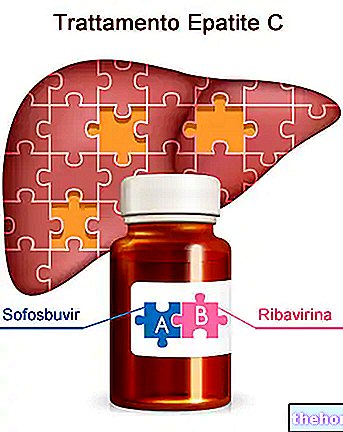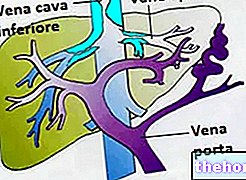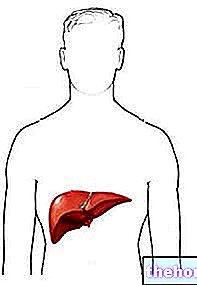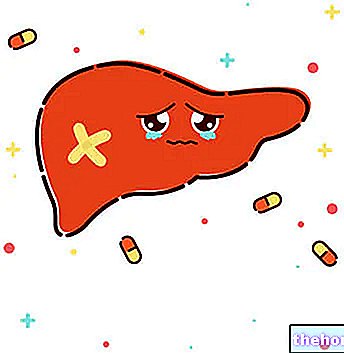To investigate the numerous liver functions, doctors have an equally large array of instrumental and laboratory tests (blood tests) at their disposal. In the majority of cases - to trace a precise morbid situation affecting the liver and at the same time establish its nature and severity - it is necessary to use specific groupings of these tests.
Blood tests that investigate liver health include the dosage of:
- enzymes of hepatocyte origin (transaminases - AST, ALT - ALP and GGT);
- direct and indirect bilirubin (urine dosage is also important);
- plasma proteins (total amount, albumin and / or globulins);
- clotting factors (prothrombin time);
- specific antibodies for hepatitis A, hepatitis B, hepatitis D and hepatitis E

Referring the reader to the individual in-depth articles (by clicking on the words underlined in blue), let us briefly summarize the general clinical significance of these liver tests.
Values
liver
ALBUMIN
Synthesized by the liver, albumin is the most abundant protein in plasma. Its values decrease in the presence of chronic liver diseases, such as cirrhosis, due to reduced synthesis. The same result can be obtained in the presence of chronic kidney diseases (syndrome nephrotic), due to the abnormal loss of albumin in the urine, but also in the presence of severe malnutrition, prolonged fasting, protein catabolism and numerous other conditions. For this reason the hepatic protein synthesis capacity is evaluated by preferably measuring other markers, such as coagulation factors.
3.9 - 5.0 g / dL
Alanine transaminase, more simply ALT, ALAT or SGPT, is an enzyme present in the mitochondria of liver cells (hepatocytes), involved in protein synthesis. When a hepatocyte is injured, this and other enzymes are inevitably released, which increase its concentration in the blood. As a result, ALT blood values increase significantly during acute organ damage, such as during "acute viral hepatitis," chronic hepatitis or a "paracetamol overdose (fulminant hepatitis) .
Aspartate transaminase (AST), also known as ASAT or SGOT, is another enzyme contained in liver cells; consequently its increase in the blood recognizes the same liver causes, although it can be more easily traced back to heart damage It is therefore a non-specific index of liver function, its values can be related to those of ALT to trace the nature - hepatic or extra-hepatic - of the increase in these transaminases. If ALT is much more elevated than AST, liver damage is plausible, and cardiac damage is plausible.
The comparison of these and other enzymes with the creatine kinase values, can confirm or deny the hepatic origin of the problem. Creatine kinase increases in fact in the presence of a muscle lesion, so normal values associated with high ALT values suggest a problem to the liver.
Alkaline phosphatase (ALP) is an enzyme contained in the cells that line the innermost layer of the intrahepatic bile ducts. Therefore, an increase in ALP values in the blood can be due to biliary obstructions of various kinds (gallstones), intrahepatic cholestasis or infiltrative diseases of the liver (for example, a tumor). Its rise is common even in the presence of osee diseases.
BILIRUBIN
TOTAL
BILIRUBIN
DIRECT
Bilirubin is a breakdown product of heme, a key component of hemoglobin contained in red blood cells. Once synthesized (indirect or unconjugated bilirubin) it is made water-soluble in the liver (direct or conjugated bilirubin), and secreted in the bile (which pours into the intestine). An increase in the total fraction with elevated unconjugated fraction and normal conjugated, it can therefore reflect a problem of liver function (cirrhosis, viral hepatitis, etc.) or an increased catabolism of red blood cells (haemolytic anemia). Mildly elevated indirect bilirubin levels, with all other liver function markers normal, are common in Gilbert's syndrome.
The excess of bilirubin in the blood gives the skin and eye sclera a yellowish color (jaundice).
TOTAL
0.1-1.2 mg / dL
DIRECT
0-0.3 mg / dL
Gamma glutamyl transpeptidase (GGT) is an enzyme involved in liver detoxification mechanisms. Its levels increase significantly in ethyl alcohol intoxication (acute or chronic).
TIME TO
PRO-
THROMBINE
This blood test measures the clotting time of the plasma; Since the liver is the key organ in coagulation protein synthesis, an increase in this range may indicate liver damage. See also INR.
LACTATE
DEHYDRO-GENASES
Lactate dehydrogenase (LDH) is an enzyme present in many tissues of the body, including the liver. It is therefore a highly non-specific index of liver function, and an increase in it may also, but not necessarily, indicate damage to the liver. (in this case the LDH 4 and LDH5 isoforms increase above all).
EXAMS
IMMUNO-
LOGICAL
In the presence of a suspicion of possible viral hepatitis, immunological tests can be carried out on the blood sample in order to search for viruses and antibodies directed against them.
The search for auto-antibodies can instead be conducted in the presence of suspicions on possible autoimmune liver diseases, triggered by the presence of abnormal antibodies directed against the same cells of the organism (primary biliary cirrhosis, autoimmune hepatitis, primary sclerosing cholangitis).
++
Among the instrumental tests used to investigate the health of the liver, a leading role is played by abdominal ultrasound, which exploits the different ability of tissues to reflect the ultrasounds emitted by an electric probe. Alternatively, magnetic resonance imaging can be used; both procedures, being free from any emission of ionizing radiation, are absolutely safe for the patient. At times, diagnostic certainty is obtained by taking a small fragment of liver tissue (frustule, carrot), using a special needle inserted into the "abdomen, obviously under ultrasound guidance and under local anesthesia. At other times, an examination called retrograde endoscopic cholangiopancreatography is used, which consists in the descent of a tube orally until it reaches the extrahepatic biliary tract. If necessary, this probe also allows for therapeutic maneuvers such as the removal of stones or the restoration of the patency of occluded canals.
Select Blood Tests Blood Tests Uric acid - uricaemia ACTH: adrenocortitotropic hormone Alanine amino transferase, ALT, SGPT Albumin Alcoholism Alphafetoprotein Alphafetoprotein in pregnancy Aldolase Amylase Ammonemia, ammonia in the blood Androstenedione Antibody-endomysial antibodies Anti-gliadicides Nucleus Helicobacter pylori antibodies Embryo carcinoal antigen - CEA Prostate specific antigen PSA Antithrombin III Haptoglobin AST - GOT or aspartate aminotransferase Azotemia Bilirubin (physiology) Direct, indirect and total bilirubin CA 125: tumor antigen 125 CA 15-3: tumor antigen 19-9 as tumor marker Calcemia Ceruloplasmin Cystatin C CK-MB - Creatine kinase MB Cholesterolemia Cholinesterase (pseudcholinesterase) Plasma concentration Creatine kinase Creatinine Creatinine Creatinine clearance Chromogranin A D-dimer Hematocrit Blood culture Hemocrome Hemoglobin Glycated hemoglobin a Blood tests Blood tests, Down syndrome screening Ferritin Rheumatoid factor Fibrin and its degradation products Fibrinogen Leukocyte formula Alkaline phosphatase (ALP) Fructosamine and glycated hemoglobin GGT - Gamma-gt Gastrinemia GCT Glycemia Red blood cells Granulocytes HE4 and Cancer at "Ova" Immunoglobulins INR Insulinemia Lactate dehydrogenase LDH Leukocytes - white blood cells Lymphocytes Lipases Tissue damage markers MCH MCHC MCV Metanephrines MPO - Myeloperoxidase Myoglobin Monocytes MPV - average platelet volume Natremia Neutrophils Homocysteine Thyroid hormones OGTT Osmocyte Plasma protein A associated with pregnancy Peptide C Pepsin and pepsinogen PCT - platelet or platelet hematocrit PDW - distribution width of platelet volumes Platelets Plateletpenia PLT - number of platelets in blood Preparation for blood tests Prist Test Total IgEk Protein C (PC) - Protein C Activated (PCA) C Reactive Protein Rast Protein Test Specific IgE Reticulocytes Renin Reuma-Test Oxygen Saturation Sideremia BAC, BAC TBG - Thyroxine Binding Globulin Prothrombin Time Partial Thromblopastin Time (PTT) Activated Partial Thromboplastin Time (aPTT) Testosterone Testosterone: free and bioavailable fraction Thyroglobulin Thyroxine in the blood - Total T4, free T4 Transaminases High transaminases Transglutaminase Transferrin - TIBC - TIBC - UIBC - saturation of transferrin Transtyretin Triglyceridemia Triiodothyronine in the blood - Total T3, free T3 Troponin TRH and Troponins of s thymol to TRH TSH - Thyrotropin Uremia Liver values ESR VDRL and TPHA: serological tests for syphlis Volemia Conversion of bilirubin from mg / dL to µmol / L Conversion of cholesterol and triglyceridemia from mg / dL to mmol / L Conversion of creatinine from mg / dL to µmol / L Conversion of blood glucose from mg / dL to mmol / L Conversion of testosteronemia from ng / dL - nmol / L Conversion of uricemia from mg / dL to mmol / L




























